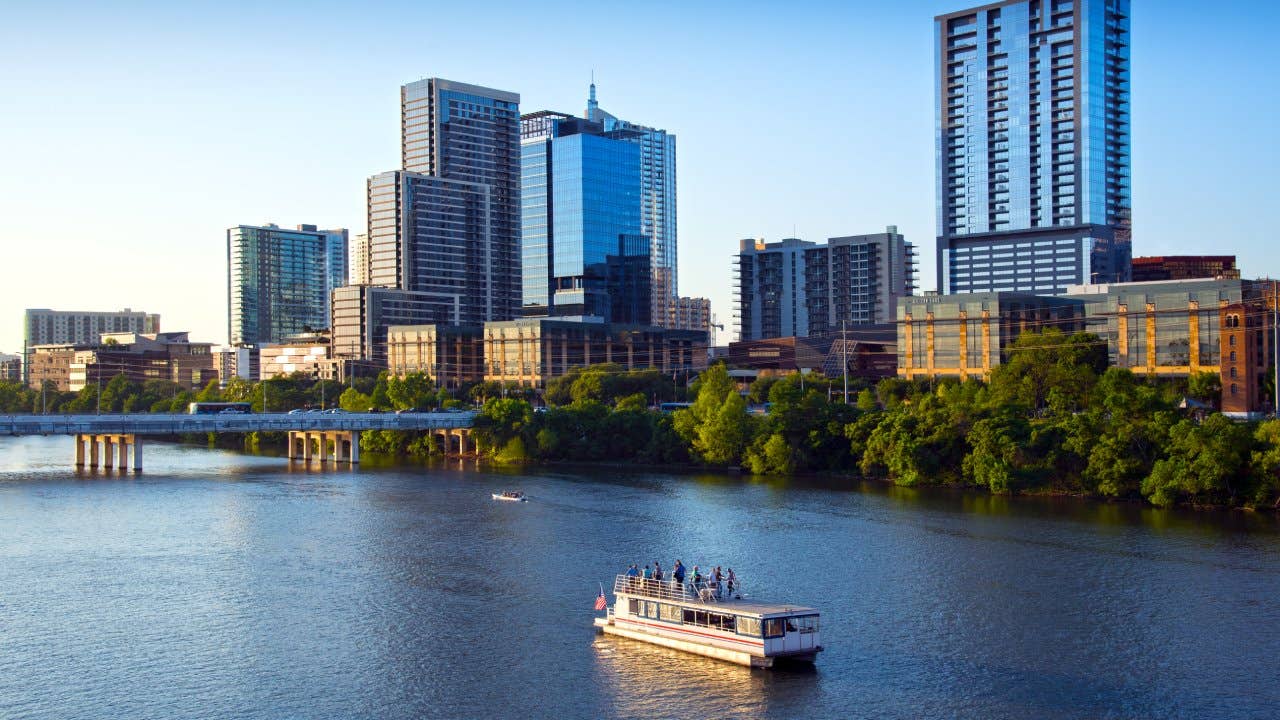Buying a house in Austin: A how-to

The Bankrate promise
At Bankrate we strive to help you make smarter financial decisions. While we adhere to strict , this post may contain references to products from our partners. Here's an explanation for .
If the capital of Texas has been calling your name, now might be the time to answer. With an always-outdoors culture and a legendary music scene, Austin is known for its amazing quality of life. It’s not just within the city limits, though. Austin’s nearby neighbor to the north, Round Rock, tops Bankrate’s recent list of the best places to live in the entire country.
Buying a house in Austin hasn’t been easy lately, as droves of newcomers have created steep competition for the limited housing inventory. Read on for everything you need to know to navigate the real estate market in the Lone Star State’s coolest city.
Why buy a house in Austin?
There are loads of reasons to plant permanent roots in Austin: fantastic weather, great nightlife and more. However, one of the big reasons to live here is the abundance of career opportunities. With companies like Google, Apple, Tesla and Oracle all setting up major operations, the city has become a hub for high-paying tech jobs. And while you can earn more here, you won’t pay as much for all your essentials versus other big cities. Bankrate’s cost of living calculator shows that Austin is around 46 percent cheaper than San Francisco — proof that at least one thing isn’t bigger in Texas.
Buying a house in Austin looks like a smart investment, too, based on the city’s promising future. According to the American Growth Project, Austin is the second fastest-growing city in the U.S. If that growth continues, home values are likely to continue to rise, too.
Find an Austin home for your budget
Unfortunately, buying a home in Austin isn’t cheap. In fact, the median sale price here in December 2022 was $457,426, according to the Austin Board of Realtors. That’s nearly $100K higher than the national median of $366,900. However, you may be able to find a better deal in certain neighborhoods, like North Lamar and Crestview. And if you’re willing to live farther from downtown, you may find even more appealing price tags. For example, the median price tag in Hays County was $414,500 in November 2022. Southeast of the city in Bastrop County, the deals look even better with a median of $362,450.
If you’re looking to buy, it’s important to do the math on how much you can afford to spend without putting yourself under serious financial stress. If you’ll need to borrow more than $726,200, you’re going to exceed the conforming loan limit in Texas. That means you’ll need to apply for a jumbo loan, which carries stricter credit qualifications and bigger down payments.
Is now a good time to buy a house in Austin?
The past two years have been tough times for Austin homebuyers, but there are positive signals for 2023. The most recent data from the Austin Board of Realtors shows that homes are sitting on the market for much longer here now — 73 days in December of 2022, a 47-day uptick from one year earlier. Additionally, Redfin data shows that homes in Austin are selling for around 96 percent of their list price. While that’s pretty good, consider that In April of 2021, homes were going for around 10 percent more than list price.
All that is good news for buyers. In fact, you might actually want to wait a bit longer to buy a house in Austin: A report from real estate company Knock forecasts that Austin will become a buyer’s market by the summer of 2023. While mortgage rates will still likely be on the high side, you may enjoy some extra bargaining power to score a better deal.
What to know about buying a house in Austin
How long will your commute be?
Thinking about your trip to and from the office is a crucial consideration here. Austin’s infrastructure was not designed to accommodate the massive influx of residents that have arrived over the past few years. A recent study from the Texas A&M Transportation Institute showed that commuters in Austin spent more time in traffic than commuters in any other similar-sized city.
How much will you pay in closing costs?
In addition to budgeting for a down payment, make sure you factor in the closing costs that will add to your bill as a buyer. One of the good things about buying a house in Texas is that you won’t pay any real estate transfer taxes, which can add thousands of dollars to a deal in other places around the country. However, you’ll still have to pay plenty of extra fees. Data from ClosingCorp shows that closing costs on the typical Texas home add another 1.5 percent of the purchase price. On a $530,000 home, that’s an extra $7,950. That figure does not include any origination or underwriting fees, though. Make sure you’re comparing the best lenders in Texas to find an option that will limit your additional expenses at closing.
How much will you pay in property taxes?
Your property tax bill will vary based on the home’s specific location, so do your research to determine the past bill for different properties you’re considering. Unfortunately, property taxes here are relatively high. Between covering obligations for the county, city, school district and other special taxes, property tax rates run around 2 percent of a home’s assessed value. So, a home with an assessed value of $400,000 would have an annual tax obligation of $8,000.
What else will you need to pay for as an Austin homeowner?
Don’t forget to budget for the cost of protecting your new property. Homeowners insurance in Texas is more expensive than many areas of the country. In addition to standard coverage, you may need to look into extra policies to cover other things, including flooding. While flood insurance in super-dry Texas may sound strange, around 7 percent of properties in Austin do have heightened risks of water damage, according to estimates from the First Street Foundation.
How safe are the neighborhoods?
Generally speaking, Austin’s safety is good for a big city, according to CrimeGrade. But there are certain areas where you’ll likely feel safer walking the dog at night than others. As you move farther from the crowds of Sixth Street and the Rainey Street District to more residential areas, criminal activity shrinks. It can’t hurt to review local police reports from any of the blocks where you’re considering buying a home.
Tips for buying an Austin home
Save for a down payment
The average down payment on a new home in the Lone Star State was $31,750 in the spring of 2022. If that kind of cash seems taller than the Texas Capitol building, don’t worry — you may be able to put down a smaller sum. If you can qualify for a conventional loan with excellent credit, you’ll need to contribute 3 percent of the purchase price. On a $530,000 home, that comes out to $15,900.
Depending on your income, you might be eligible for one of Texas’s first-time homebuyer programs. In Austin, a one- or two-person household earning less than $110,300 per year may be able to score a 5 percent interest-free loan for down payment and closing costs. There is also a local program specifically geared toward low-income buyers that can help you get up to $40,000 in down payment assistance for a home that costs less than $380,000.
Find a local Austin real estate agent
No matter what your budget is, what kind of home you’re hoping to buy or where you’re hoping to live, there is one common piece of the puzzle for every buyer: A professional real estate agent is a must. As the market here continues to tilt toward the buyer’s favor, your agent will play a crucial role in helping you avoid the common homebuyer mistakes. And if you’re one of the many people who wants to relocate from another state, an agent is even more important. He or she can be your eyes and ears, alerting you to new listings and guiding you through the process from afar.
Get preapproved for a mortgage
Before you start looking at properties, be sure to get preapproved for a mortgage. It’s a simple (and free) step that involves sharing a range of your financial information with a lender. Be ready to submit pay stubs, tax returns and bank account information. Some lenders can automatically give you a preliminary approval in as little as 15 minutes. That preapproval letter will be key to getting a seller to take you seriously.
Understand the playing field
As you start to look at listings in Austin, it’s important to have a sense of your competition. Despite a serious slowdown in iBuying activity across many parts of the country, Opendoor and Offerpad — the two biggest names remaining in the iBuying world — are still actively purchasing properties here. In addition to companies that have deep pockets, there are plenty of individuals with sizable savings, too. Just a year ago, nearly a quarter of Austin sales were all-cash deals. It’s tough to say whether that trend will continue in 2023, but you may want to explore options that can give you any kind of competitive edge, such as a cash-backed bid.
Bottom line
While buying a house in Austin felt nearly impossible for a lot of people throughout the pandemic, the rise in mortgage rates makes it feel less like the scorching Texas sun and more like a calm autumn breeze. Homes are taking longer to sell, and prices have leveled off. You’ll still pay a lot to get the keys, but it seems like the page is turning from the pandemic-fueled level of competition to a more manageable market.
FAQs
-
While Austin isn’t a cheap place to buy a home, the real estate market here is looking quite a bit more buyer-friendly in 2023. More sellers have been dropping their prices, according to data from Redfin, and properties are staying on the market longer. The days of intense bidding wars are gone, and buyers are slowly getting more bargaining power as the housing market cools off.
-
Housing costs here are quite high. But outside of that, the cost of living in Austin is comparable to the rest of the country. According to data from the Austin Chamber of Commerce, the overall cost of living here is only 1 point higher than the national average, thanks to more affordable transportation, groceries and utilities.
Related Articles



